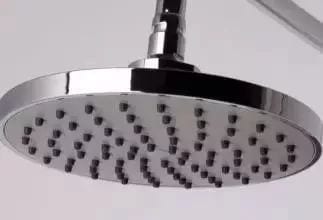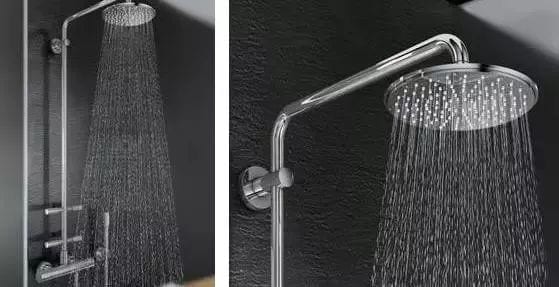Xiao Xin Bathroom Headline
Do you feel itchy all over your body if you don’t shower for 3 days?
Once you take a shower, you can’t do without the shower. Have you ever tried to take a shower and your whole body still itches?
If you’ve just taken a shower, your skin feels dry, itchy and miserable all over. Aside from ruling out a few skin conditions, you might want to clean your showerhead as well.
According to a new study published in the Proceedings of the National Academy of Sciences, showerheads, especially those made of plastic, not only harbor bacteria, but are also a perfect breeding ground for harmful bacteria.
Showerheads harbor germs
Not long ago, a major survey was conducted in the United States on the levels of bacteria in the air and water in homes, schools and public buildings. Researchers from the University of Colorado sampled and tested 45 showerheads in five states.
The results showed that tens of thousands of bacteria were harbored in almost every showerhead, and 30 percent of them were detected to contain a bacterium that can cause lung disease (Mycobacterium avium). Researchers note that this bacteria is very common in urban water systems. But drinking water is usually heated at high temperatures, which kills these disease-causing bacteria. And the amount of this bacteria on showerheads is 100 times greater than in tap water. When people take a shower, the jet of water from the showerhead can easily be inhaled and cause an infection.
The head of the new study, Norman Pease, said healthy people with normal immune systems have nothing to worry about. But the elderly, children, pregnant women and people with poor immune systems are more susceptible to infection. Symptoms of contracting the bacteria include fatigue, a persistent dry cough, shortness of breath, weakness and feeling sick all over.
How to clean your shower
Showerheads, because of prolonged use, can suffer from internal deposits of dirt that clog the shower holes, resulting in a reduced water flow.
Therefore, some people use strong acid to clean the showerhead. However, this not only corrodes the showerhead, but also causes secondary damage.
Therefore, to avoid damage to the showerhead, these are the cleaning methods you must understand!
Soak it in vinegar
Prepare some white vinegar first, then pour the vinegar into a bowl and submerge the shower head in the vinegar for 10 minutes to remove the dirt from the shower head water.
Use lubricant
If the metal of the shower head rusts and causes severe clogging, use a rust-preventive lubricant. Use the lubricant to separate the rusty layer from the metal layer, creating a protective film.
This is ideal if your showerhead is made of stainless steel.
Needle prick
Clean the needle into the outlet hole one by one, so that the scale from the outlet hole off, and then fill the water from the inlet into the nozzle. Shake to clean and then pour out the water, so that the scale can be fully cleaned.
Rub the outlet nozzle
Many showerheads now use a soft thermoplastic elastomer for the spout.
For this type of showerhead, simply rub the spout gently to break up any debris. Repeat 2 to 3 times, let the water rinse can be.
However, when rinsing, be careful:
- When using the showerhead, you should be careful not to apply too much force. You should not bend or even damage the hose to which the shower is connected.
- When cleaning the shower, if there is a stain that is difficult to remove, cut a slice of lemon and use it to clean the stain. Do not soak the shower in strong acidic liquid to avoid corrosion of the shower.
If your shower has been used for a long time, it will accumulate dirt, which can lead to the accumulation of harmful bacteria and impurities.
I suggest that you replace the shower with another one to avoid any health problems.
How to maintain your showerhead
- The ambient temperature should not exceed 70 degrees Celsius. High temperature and ultraviolet light will greatly accelerate the aging of the shower, shortening the life of the shower. Therefore, the installation of the shower as far as possible away from the bath heater and other electrical heat sources. The shower can not be installed directly below the bath, and the distance should be more than 60CM.
- In areas where the water is hard, you should use a showerhead with a plastic spout or a self-cleaning device. Even if the shower outlet is clogged with limescale, it will be easier to clean. Do not dismantle the showerhead. Due to the complex internal structure of the showerhead, unprofessional dismantling will result in the showerhead not returning to its original state.
- Don’t use too much force when opening and closing the faucet and adjusting the water dispensing method of the shower, just turn it gently in a downward motion. Even for traditional faucets, it is not necessary to spend a lot of force. Take special care not to use the handle of the faucet or the shower stand as a handrail for support or use.

- The metal hose of the shower head should be kept in a natural stretching state, and should not be coiled around the faucet when not in use. At the same time, pay attention to the hose and faucet joints do not form a dead angle, so as not to break or damage the hose.
- Every six months or less, remove the shower and place it in a small basin. Soak the shower surface and inside with white vinegar for 4-6 hours, then gently wipe the shower surface with a cotton cloth to clean the spout. Reinstall the joint and let the water run for a few moments to allow the white vinegar and water scale to flow out to eliminate or reduce the impact of the scale on the shower, which will have a certain sterilizing effect on the cleaning of the shower.
 VIGA Faucet Manufacturer
VIGA Faucet Manufacturer 

